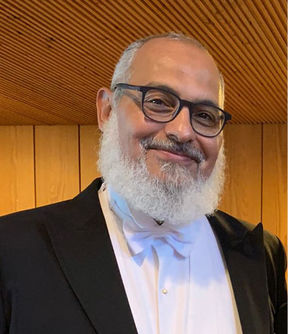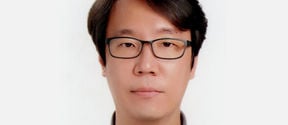Hossam Hewidy: ‘Increasing multiculturalism must be taken into account in urban planning’

What is your research about?
‘In my dissertation, I study the clusters of immigrant amenities in Helsinki and whether urban planning can integrate them into its policies and the growth of the city. Concentrations of services related to foreign cultures have emerged in different parts of Helsinki. Such services, whether secular or spiritual, represent the spatialization of multiculturalism and are an important part of the daily lives of city dwellers. Being an immigrant equipped with cultural understanding, I started this research inspired by my own observations in the amenities I frequent.
These clusters are often hidden in places abandoned by mainstream retail, which I call in this dissertation ‘urban leftovers’. Despite the domination of chain stores, retail oligopoly and spectacular malls, immigrant amenities have become an emerging phenomenon converting these leftovers into livable urban hubs. These hubs are a creative solution invented by immigrants to cope with their low representation in the labour market. In addition, they fulfil both economic and social needs of the immigrant community.
The transformation of the urban space caused by such clusters gives the multicultural manifestation its spatial dimension; thus, it poses challenges on the planning system. As the leftovers are located in neighbourhoods with a relative overrepresentation of immigrant population, these neighbourhoods are exposed to urban renewal steered by anti-segregation policy, thus facing the threat of erasure. Therefore, I found myself asking: how can planning in a multicultural community consider immigrants and their spatial needs? This dissertation raises awareness on the issue of multicultural planning.’
What's important in it?
‘The results of my research show that the transformation by immigrant amenities is enterprising and innovative. The clusters of immigrant amenities have spontaneously enabled a bottom-up place making process and converted Helsinki’s leftovers into liveable places full of meanings contributing to the recovery of public street life and empowering a warm place for cultural visibility and attachment.
Despite these positive effects, the strip malls hosting these clusters will be demolished. The results of the study further show that urban planning has failed to take multiculturalism into account in a growing city. The city is pursuing a policy of responding to segregation, and measures to limit it are destabilizing multiculturalism. The data processed by the study show that this phenomenon is reflected in both traditional design and alternative design methods, such as scenario planning and urban planning competitions. I claim that the planning system lacks a clear vision of a multicultural city. Urban planning processes have failed to take immigrants into account in urban development.
Architect Hossam HewidyMulticultural city is not the result of chance, but rather a conscious goal for which design can create conditions or obstacles."
I further call for reducing the exaggerated fear of segregation that prevents the city from considering multicultural manifestation a potential not a threat. Many European cities acknowledge similar immigrant amenity clusters as job creators and authentic hubs attracting both tourists and co-ethnic clientele. Thus, diversity, celebrated in many cities as attractive destination or new market niche, will be simply lost from Helsinki.’
What may it lead to?
‘The Finnish research unconsciously creates a negative perception of multiculturalism by solely focusing on segregation and relevant housing studies. Consequently, municipal planning adopts an anti-segregation dispersal policy seeking an even socioeconomic distribution. Simplifying the response of the city to the spatialization of multiculturalism is in fact a restrictive control of the immigrants’ spatial pattern that withdraws their right to urban space. I argue that multicultural planning is a question of equality: the equal right of every citizen to urban space and whether planning can be culturally neutral.
Thus, I strongly argue that there is a need for research defining, what is multicultural planning and informing the practice and urban policies on how to deal with immigrants beyond anti-segregation policies. The message of my dissertation is that a multicultural city is not the result of chance, but rather a conscious goal for which design can create conditions or obstacles.
The findings of my dissertation contribute to immigrant integration and wellbeing through spatial planning and raise the awareness of immigrant retail clusters as a potential enjoying unique characteristics to resist urban homogenisation and create authentic and exotic destinations. I argue that urban regeneration should carefully treat the places created by immigrants and prioritise their social and cultural use value. Otherwise, the immigrant right to the city will continue to be declined.’
Hossam Hewidy defended his dissertation The hidden city of immigrants in Helsinki's urban leftovers: The homogenization of the city and the lost diversityat Aalto University 21 August, 2022.
Contact:
Hossam Hewidy, Aalto University School of Arts, Design and Architecture, [email protected], +358415361119
- Published:
- Updated:
Read more news

Min-Kyu Paek has been appointed Assistant Professor at the Department of Chemical and Metallurgical Engineering
Min-Kyu Paek has been appointed Assistant Professor at the Department of Chemical and Metallurgical Engineering
Aalto ARTS alum Vidha Samya’s artwork featured at the Venice Biennale 2024
The Pavilion of Finland presents ‘The pleasures we choose’ at the 60th International Art Exhibition – La Biennale di Venezia until 24 November 2024.
IoT Forge donates EUR 1 million to the School of Engineering
The donation will be used for research and education on the Industrial Internet and digital twins.